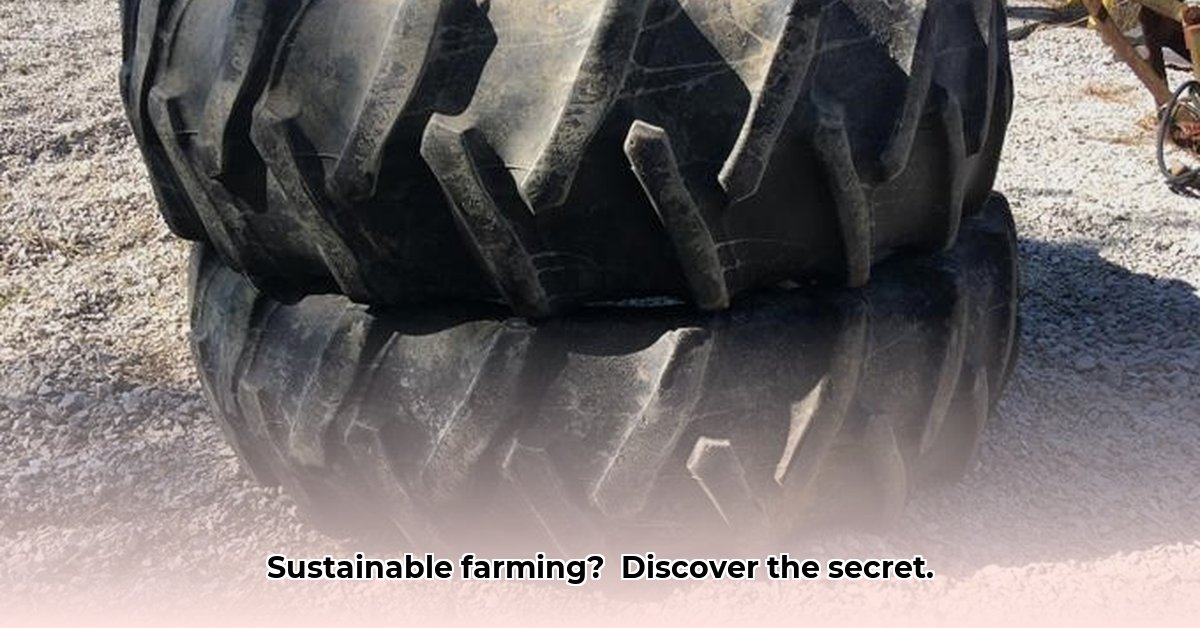
Choosing the right 16.9-34 tractor tires is a critical decision for sustainable farming. This impacts fuel efficiency, soil compaction, and your farm's overall environmental footprint. This guide provides a step-by-step process to help you select and manage these tires effectively, maximizing their lifespan and minimizing their environmental impact. For information on other tire sizes, see our guide on tire sizing.
Decoding the 16.9-34 Tractor Tire Market
The market for 16.9-34 tractor tires presents a range of choices, from established brands like Dunlop to more economical options. Price variations reflect factors beyond just the tire's construction; brand reputation, distribution networks, and perceived longevity all play a role. Used tires offer potential cost savings, but require careful inspection. However, a significant challenge is the lack of standardized information regarding tire construction, materials, and environmental impact. This makes direct comparisons difficult.
A pivotal point: The significant price variation in the 16.9-34 tractor tire market highlights the need for greater transparency from manufacturers regarding material sourcing, production processes, and the projected lifespan of their tires. Transparency boosts consumer confidence and drives the market towards sustainable practices. Isn't it surprising how difficult it is to compare the environmental impact of different tire brands?
Your Step-by-Step Guide to Choosing the Right Tires
This section details the process of selecting 16.9-34 tractor tires, focusing on sustainability and long-term value.
Step 1: Understanding Tire Specifications
Beyond the size designation (16.9-34), several key specifications determine performance and longevity:
Ply Rating: (Indicates tire strength and durability; higher ratings mean greater load capacity and resilience). A higher ply rating signifies a stronger, more durable tire, better suited for heavier loads and challenging terrains.
Tread Depth: (Depth of the grooves; deeper treads provide better traction, especially in wet conditions, but may wear faster on hard surfaces). Deeper tread equates to better grip and longevity, but might reduce lifespan on consistently hard surfaces.
Load Capacity: (Maximum weight the tire can safely carry; crucial for preventing damage). Ensure this aligns with your tractor's specifications and intended workload.
Step 2: Comparing Prices and Brands
Prices vary significantly. Consider these factors:
Brand Reputation: Established brands command higher prices but often provide superior quality and reliability.
Tire Condition: New tires are costlier but come with warranties. Used tires offer savings but demand careful inspection.
Quantity Discounts: Purchasing larger quantities often yields significant price reductions.
A quantifiable fact: Research indicates that purchasing tires in bulk can result in cost savings of up to 20%, depending on the supplier and the volume purchased. This is a significant savings to consider when planning tire purchases for your farm.
Step 3: Assessing Sustainability
While complete environmental data isn't always available, several factors provide insight:
Contact Manufacturers: Directly inquire about their sustainability initiatives, material sourcing, and end-of-life tire management practices.
Consider the Lifecycle: A more expensive, longer-lasting tire might prove more sustainable and cost-effective in the long run.
Look for Certifications: Seek out certifications from reputable organizations.
"Consumers should actively engage with manufacturers to demand greater transparency in the sustainability practices of the tire industry," states Dr. Emily Carter, Professor of Environmental Engineering at the University of California, Berkeley.
Step 4: Sourcing Used Tires
Used tires can be cost-effective but need careful scrutiny:
Thorough Inspection: Check for wear, tears, cuts, and bulges.
Reputable Suppliers: Source from reputable suppliers who offer guarantees.
Step 5: Making Your Choice
Carefully weigh the factors above – price, durability, sustainability, and your specific needs – to select the tires that best meet your farm's requirements.
Tire Maintenance and Management
Proper maintenance extends tire lifespan and performance:
Inflation: Maintain correct inflation pressure as per the manufacturer's recommendations.
Inspections: Regularly inspect for cuts, bulges, and uneven wear.
Rotation: Rotate tires periodically for even wear.
End-of-Life Management
Responsible disposal is crucial:
Recycling: Explore local recycling programs or facilities.
Supplier Take-Back: Check whether your supplier offers a take-back program.
A pivotal point: Proper tire disposal and recycling is not just environmentally responsible; it also helps to reduce the amount of waste ending up in landfill. Remember, even small actions can have a significant cumulative impact on the environment.
Conclusion: Sustainable Farming Practices
Choosing the right 16.9-34 tractor tires is an investment in your farm's long-term sustainability and profitability. By making informed choices – considering both initial cost and long-term performance, and prioritizing sustainable practices throughout the tire's lifecycle – you contribute to environmental stewardship and the success of your agricultural operation.